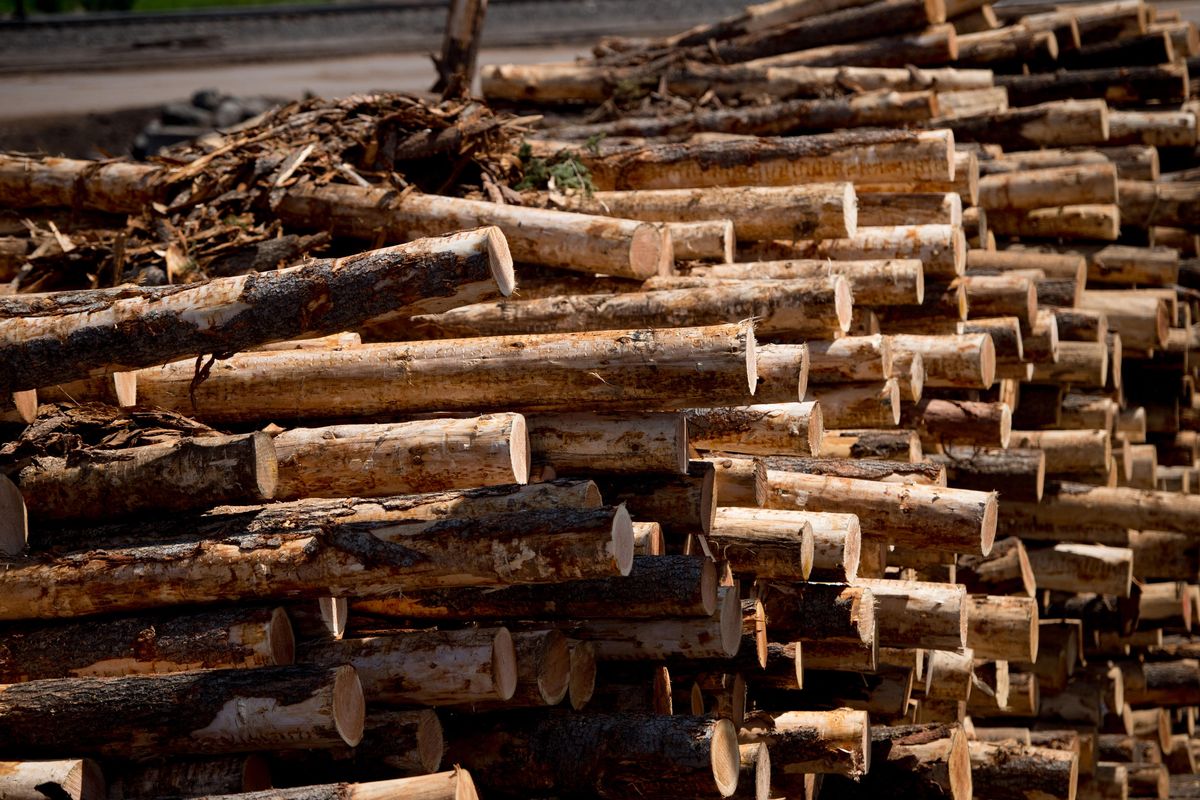Vaagen spinoff will turn scrawny trees into engineered building material

A spinoff of Vaagen Brothers Lumber Inc. plans to start making a product that could transform how high-rise buildings are constructed, someday making wooden skyscrapers part of city skylines.
By late next year, Vaagen Timbers LLC plans to begin producing cross-laminated timber in Colville.
The sturdy, structural panels are made from compressed wood where the grain is layered at 90-degree angles. The panels are strong enough to replace concrete and steel in multistory buildings.
In Portland’s Pearl District, the city recently approved permits for an 11-story, cross-laminated timber building. The 148-foot tall structure received a $1.5 million federal grant for tall buildings constructed out of wood.
In Spokane, a Cross-Fit gym built out of cross-laminated timber is nearing completion in the University District.
“It’s still a new market, but I saw enough opportunities with it to step away from my duties with Vaagen Brothers Lumber to develop this company,” said Russ Vaagen, Vaagen Brothers’ former president, who will head up Vaagen Timbers.
Just a handful of companies in the Northwest produce cross-laminated timber, also known as CLT. Vaagen – which pioneered the use of small-diameter trees for lumber production in the 1990s – would be the first CLT producer in Washington.
Supporters say CLT shows promise on a number of fronts. The panels can be made out of scrawny trees culled from forests to reduce fire danger, which might not otherwise be economical to harvest.
If the wood replaces steel and concrete building materials, which are energy-intensive to produce, it reduces the structure’s carbon footprint. Wood also sequesters carbon, keeping it out of the atmosphere.
And if CLT takes off as a building material, it would create manufacturing jobs in struggling, rural timber towns.
Revenue stream for forest thinning
Last year, the state of Washington’s capital budget included $5.5 million for a pilot project to build 20 elementary school classrooms out of CLT.
An Oregon company supplied the material for the classrooms because Washington currently doesn’t have a producer.
“There’s a gap right now, but we’re hoping to change that,” said Hilary Franz, Washington’s public lands commissioner.
Franz was in Colville on Wednesday to talk about speeding up the restoration of Washington’s forests.
Across Washington, about 2.7 million acres of forests are in poor condition and should be thinned to make them healthier and more resilient to wildfires, she said. The state Department of Natural Resources is asking for $15 million from the state Legislature over the next two years for thinning and restoration work.
Products such as CLT could help state government create a revenue stream from the undersize trees that are culled, Franz said.
If the state sells the timber, Vaagen said he can turn the weedy logs into a viable product. Thinning an acre of forest creates about one truckload of logs.
“I think it will add a lot of value to the restoration work we’re doing in the forest,” Vaagen said.
Europe is years ahead with CLT buildings
Vaagen was in Germany and Austria last month to look at equipment for CLT production. Europe is at least a dozen years ahead of North America for CLT use in its construction, he said.
In the United Kingdom alone, there are about 600 CLT buildings, Vaagen said. About 60 European plants manufacture the product.
Vaagen has been working closely with a British Columbia company, StructurLam, which makes CLT. The Penticton facility uses scraps of lumber from Vaagen’s Colville mill as part of its raw material supply.
StructureLam provided the panels for Spokane’s first CLT building, which was erected this spring. Kevin Longmeier, the owner of a Cross-Fit gym, chose CLT for his new $765,000 building in the University District.
“I liked that it was eco-friendly, and aesthetically, the wood looks pretty cool,” Longmeier said.
Many Cross-Fit gyms are steel buildings because the walls have to be strong enough to support pull-up bars and other equipment, he said. The exposed CLT panels in the interior will give the gym a warmer look, Longmeier said.
His contractor, Mike Bradley of Beacon Builders, also sold him on the CLT’s “quick build” time. Because the product comes in panels, the building at 711 N. Helena St. went up in about three weeks.
Spokane’s building code treats CLT as heavy timber frame construction, said Dean Giles, the city’s acting building official. Under city code, a CLT office building could be five stories tall; with a sprinkler system, six stories would be allowed.
The 11-story building in Portland’s Pearl District received a federal grant to show how CLT could be used in taller buildings. The Portland high-rise has to meet local fire and earthquake codes.
Environmentally conscious a selling point
Russ Vaagen anticipates most of the initial demand for CLT coming from mid-rise apartments and commercial buildings.
He also sees a market for CLT in modular structures, such as military housing or tiny home construction. CLT panels can also be used as flooring systems.
“It’s going to be a little bit of a shift to go from traditional framing to full panelized structures,” he said.
There’s tremendous interest in CLT, particularly from politicians, said Duane Vaagen, Russ’ dad and the president of Vaagen Brothers Lumber. But the number of North American buildings made out of CLT is still quite limited, he said.
“It’s not a stock item in your Home Depot store,” Duane Vaagen said.
Part of the work of Vaagen Timbers will be getting the CLT story out to builders and the public, Russ Vaagen said. He’s confident that the product will sell itself to people who support environmentally friendly construction.
“We’re going to capitalize on social media to show people where this product comes from,” he said. “They can be proud they bought a product that helps reduce the risk of wildfire, reduces greenhouse gas emissions and restores forests to more natural conditions.”